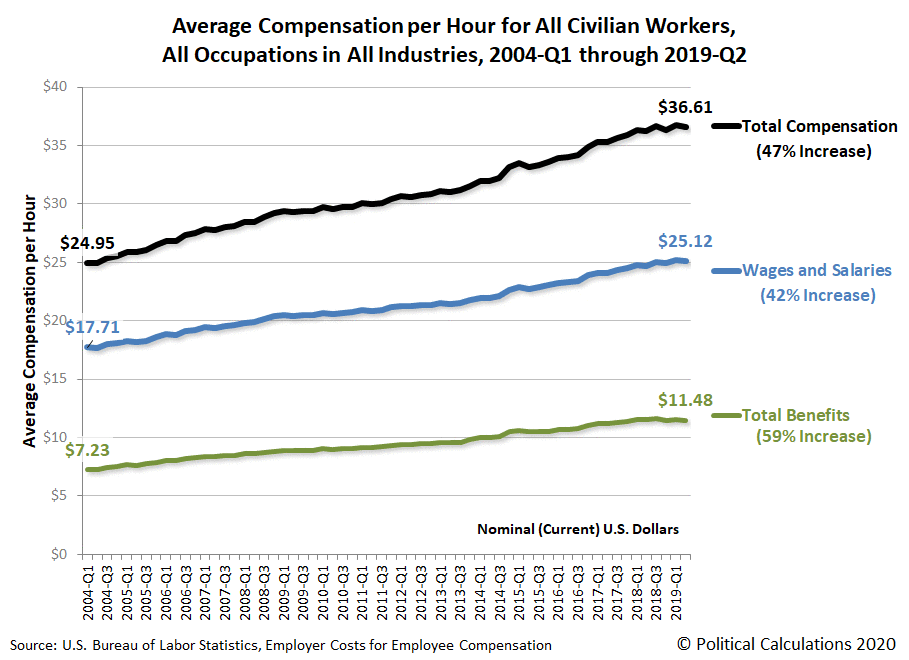Choosing Between Wages And Benefits In Employee Compensation
We had been planning on updating our series on the trends in median household income today, but since the data for December 2019 won't be available until Thursday, we've put that on hold until Friday. In the meantime, we'll take a question from one of our readers, who recently asked:
What we should all be asking is why real wages, adjusted for inflation, have been flat for so long. Who cares if unemployment is low and the stock market keeps reaching new highs if you look around and your friends and neighbors have the same standard of living for 40 years? Why can't we share in the prosperity?
Why indeed?! To answer the question, we've tapped the Bureau of Labor Statistics' database that captures the costs that U.S. employers have in compensating their employees, where we've extracted the average dollar amounts they've paid in wages and salaries and fringe benefits to all civilian workers in each quarter from 2004-Q1 through 2019-Q2. We've also adjusted that data for inflation, where the following animated chart cycles between the nominal and inflation-adjusted results over these 15+ years worth of total employee compensation data.

We're only covering these 15+ years because the detailed data for benefits isn't available before 2004-Q1. It is, however, enough data to answer the question because it confirms is that inflation-adjusted wages and salaries have been mostly flat during this time, rising just 4%.
It also confirms that the portion of compensation that employers pay to their workers in the form of benefits has risen by 16% after accounting for inflation over the same period of time. Together, the combined total of wages and salaries with benefits has risen in inflation-adjusted terms by 7% from 2004-Q1 through 2019-Q2.
What that tells us is that if you are only looking at the portion of your compensation that you receive in the form of wages or salaries, you're choosing to ignore the bigger picture where your standard of living is involved, because that is determined by your total compensation which consists of both paychecks and benefits from your employer.
The real question is why is employee compensation in the form of benefits rising so much faster on average than wages and salaries?
The answer to that question is because you, as an employee, have wanted it to. That's because the benefits your employer provides you as part of your total compensation, such as for health insurance, are not subject to income taxes. If you zeroed out those benefits and converted all your compensation to be in the form of wages, which would be fully subject to income taxes, your after-tax total compensation would be reduced below the equivalent amount you are effectively taking home today and you would be worse off in your standard of living.
The question for you would then shift to be one of how much you value the benefits your employer provides. Would you be willing to pay what your employer must provide them to you at the level to which you've become accustomed? Or would you skimp on them so you can have more cash to spend on other things you value more to "share in the prosperity"?
The choice for employees to take more of their compensation in the form of untaxed benefits instead of wages and salaries has been being made for much longer than 15 years. Or 40 years. In the U.S., we would have to go back more than 75 years to World War 2, which is when income-tax-free health insurance benefits became widely adopted as a way to allow employers to attract and retain highly-skilled employees when wartime wage controls prevented them from paying their employees higher wages for their talents.
If that arrangement wasn't beneficial for employees, it wouldn't have continued for so long after the war ended.
References
U.S. Bureau of Labor Statistics. Employment Cost Trends: Employer Cost for Employee Compensation. [Online Database]. Accessed 4 February 2019.
Organization for Economic Co-operation and Development. Main Economic Indicators: Consumer Price Index: Total All Items for the United States (Quarterly, Seasonally Adjusted). [Online Database]. Accessed 4 February 2019.
Disclaimer: Materials that are published by Political Calculations can provide visitors with free information and insights regarding the incentives created by the laws and policies described. ...
more


